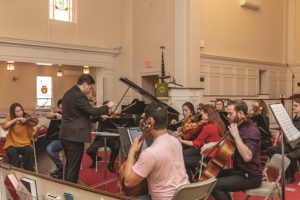Could this be a new age for chamber music? With small ensembles and limited audiences, chamber music certainly seems more Covid-friendly than, say, Mahler’s “Symphony of a Thousand.” But what are the logistics of performing chamber music right now, and how are Cape ensembles adapting?
Battle of the Instruments
Greek mythology tells of a musical contest between the god Apollo, who played the lyre, and the satyr Marsyas, who played the pipes. Apollo won because of a few party tricks: unlike his hairy opponent, he could play upside down, even while singing — he didn’t need his mouth to play.
This story captured the Renaissance imagination, especially the idea of a division between elegant string instruments and lowly wind instruments. And it has some added relevance today. When it comes to Covid, not all instruments are equal. Studies show that singing and playing wind instruments may expel more of the virus. These musicians also cannot perform while wearing a mask.
That is why Gov. Baker’s current guidelines, which allow outdoor performances only, require singers and wind players to maintain more distance during a concert than string players and other instrumentalists. Singers and wind players must stay 10 feet apart and 25 feet from the audience, while everyone else must clear only the standard six-foot separation.
Breathing Together
Matthew Scinto, conductor of the Cape Cod Chamber Orchestra, says that higher expenses preclude live outdoor performances for his ensemble. Between finding an outdoor venue with enough cover — wooden string instruments do not like the rain — and hiring a sound engineer for amplification, it’s simply not feasible.
Right now, “If you do a chamber music concert, it’s going to be virtual,” Scinto says. And that is indeed what his group is planning for late September. A reduced ensemble of about 10 string players will rehearse on Cape Cod and shoot a concert at Yarmouth’s New Church.

Scinto emphasizes that “an orchestra is not a string quartet.” You can’t round up four orchestral players and expect them to mesh perfectly, since chamber music requires hours of rehearsal and getting to know each other closely. This is “subtle stuff for most listeners.”
One challenge Scinto foresees is how the musicians will play with masks. “Such an important part of string playing is breathing together,” he says.
Musical Communication
Craig Combs, artistic director of Chamber Music for the Outer Cape, which is based at the Pilgrim Monument and Provincetown Museum, is similarly planning a live-stream concert for Aug. 20.
It will consist of works by Fauré, Copland, and William Grant Still played by violinist Jeffrey Thurston; theater pieces performed by singer Halcyon Hurst; and Beethoven’s “Moonlight” Sonata, performed by Combs on piano.
Combs says he hesitated to include a singer, as they “expel the virus more efficiently.” But all the instrumentalists will wear masks, and the singer will be positioned to face the double doors leading outside. Even so, “It’s quite difficult right now to rehearse,” he says.
While a live-stream concert scratches a certain itch, it is not the same as an in-person performance. “In chamber music there is communication,” Combs says. “And when you have an audience, it is so much more interesting. You get feedback. You hear someone take a breath during a particularly beautiful passage. Normally, we are not very far from the audience, maybe five feet. They are right there with us — they are hearing us breathe.”
Another Provincetown series offering chamber music is Great Music on Sundays @5, which traditionally had its spring-to-fall season at the Unitarian Universalist Meeting House. On Aug. 16 and 30, the series will present live-stream concerts of baroque music performed by Greg Gettel on trumpet, soprano Elise Groves, Frederick Jodry on clavier, and Eric Maul on flute.
A Question of Intimacy
The Cape Cod Chamber Music Festival, which brings world-class musicians to Wellfleet and around the Cape every August, announced they would be going virtual back in May.

Artistic directors Jon Manasse and Jon Nakamatsu will narrate three hour-long programs of archived performances from the festival. These will be released on the first three Tuesdays of August. There will also be a video event with memories, anecdotes, and musical clips by artists who have graced their stage.
Originally, there was going to be a live recording session with musicians in New York City, but travel restrictions have made it unfeasible for the time being. Nakamatsu, who is from California, would have to quarantine for two weeks.
“The basic tenet of chamber music is that it is intimate,” says Manasse. Though this can be construed as a positive, with fewer people, there is also an element of closeness that is currently unachievable.
“If you’re reviewing concerts now, and they only allow 10 people in the audience, you can write ‘to a sold-out crowd,’ or ‘a packed hall,’ ” Manasse jokes.
Manasse, who’s a clarinetist, says he played in a socially distant concert in Colorado in June, separated from his colleagues by plexiglass. “The string players were wearing masks, and we realized that there is so much subtle nuance to facial gestures,” he says. “Just the littlest thing can communicate direction, color, feeling, ensemble.”
Nakamatsu agrees that communication in chamber music is subtle and mysterious, and he wonders how it will be affected by the pandemic. “When your artistic sense is so compatible and so attuned to each other, that goes beyond the mechanics of it,” he says. “It’s an aesthetic, almost spiritual thing.”



